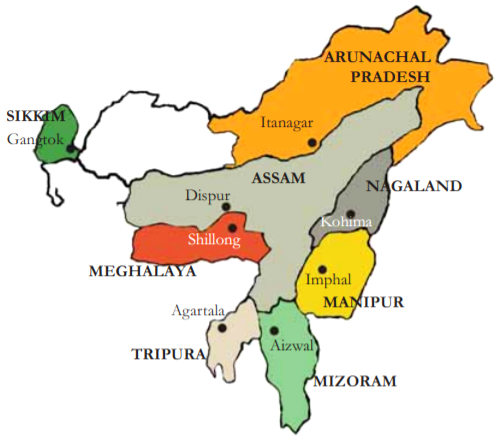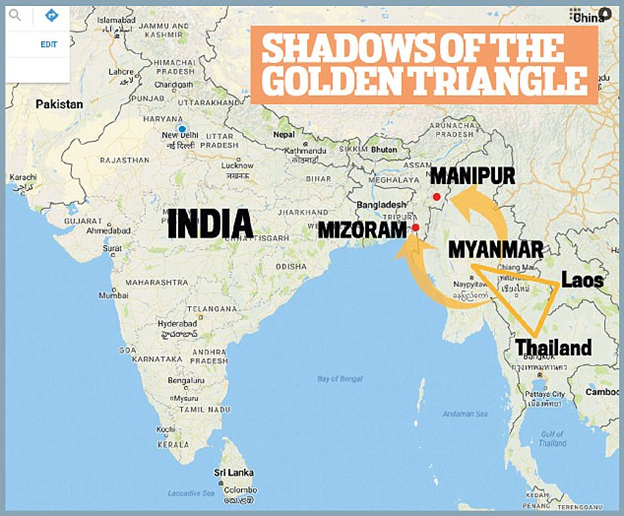Northeast: India’s Untapped Frontier
This editorial is based on “Rhetoric of Collective Action in North East India '' which was published in Economics and Political Weekly on 22/06/2024. The article brings into picture the limited effectiveness of cooperatives in Northeast India, exemplified by GIN-FED relying on traders instead of empowering indigenous growers directly, undermining local community institutions essential for cooperation.
For Prelims: India's Northeast region, Recent conflicts like Manipur, India-Myanmar-Thailand Trilateral Highway, Kaladan Multi-Modal Transit Transport Project, India's 'Act East' policy, Kaziranga, North East Industrial Development Scheme, Golden Triangle, Ginger Growers Cooperative Federation.
For Mains: Significance of the North-East Region for India, Major Challenges Related to India’s Northeast Region
Nestled in the eastern Himalayas, India's Northeast region is a land of breathtaking landscapes, diverse cultures, and rich tribal heritage. However, this region faces a significant challenge in fully integrating its indigenous communities into the mainstream development narrative.
Despite being endowed with natural resources and a vibrant cultural identity, the Northeast struggles with issues like weak infrastructure, limited access to markets, and social inequalities and recent conflicts like Manipur. One example of this complexity is the case of ginger cultivation in Karbi Anglong, Assam. Here, a cooperative society aimed to empower indigenous ginger growers but ultimately failed due to factors like the weakening of traditional institutions and the dominance of exploitative middlemen.
This case highlights the need for India to do more to bridge the gap between its Northeast region and the rest of the country. By investing in its Northeast, India can unlock a treasure trove of cultural richness, economic opportunity, and environmental stewardship.
What is the Significance of the North-East Region for India?
- Strategic Geopolitical Location: The Northeast is envisioned as a key economic corridor connecting India with Southeast Asia.
- Infrastructure projects like the India-Myanmar-Thailand Trilateral Highway and Kaladan Multi-Modal Transit Transport Project are not just about regional connectivity but about positioning India as an economic counterweight to China in Southeast Asia.
- Its unique geographical position makes it crucial for India's 'Act East' policy, aimed at strengthening economic and strategic ties with Southeast Asian nations.
- Rich Biodiversity and Natural Resources: The Northeast is one of the world's biodiversity hotspots, home to numerous rare and endemic species of flora and fauna.
- Its diverse ecosystems, ranging from tropical rainforests to alpine meadows, play a crucial role in maintaining ecological balance and combating climate change.
- The region also possesses significant reserves of oil, natural gas and coal, making it a valuable source of natural resources for India's growing economy.
- Cultural Diversity and Ethnic Mosaic: With over 220 ethnic groups and an equal number of dialects, the Northeast represents India's cultural diversity in microcosm.
- This richness of cultures, traditions, and languages contributes significantly to India's pluralistic identity and soft power on the global stage.
- The region's unique cultural heritage, including its music, dance, handicrafts, and culinary traditions, offers immense potential for cultural tourism.
- Agricultural and Horticultural Potential: The Northeast's diverse agro-climatic conditions make it suitable for cultivating a wide range of crops, including many high-value and exotic varieties.
- The region has significant potential in organic farming, floriculture, and cultivation of medicinal plants, which align with growing global demand for organic and natural products.
- Hydroelectric Power Generation: With its abundant water resources and mountainous terrain, the Northeast has immense potential for hydroelectric power generation.
- The region is estimated to have about 58,000 MW of hydropower potential, nearly 40% of India's total.
- Harnessing this potential could not only meet the region's energy needs but also contribute significantly to India's renewable energy goals.
- Tourism Potential: The Northeast's pristine landscapes, diverse wildlife, unique cultural heritage, and adventure tourism opportunities present significant untapped potential for the tourism industry.
- From the rhino-inhabited grasslands of Kaziranga to the living root bridges of Meghalaya and Keibul Lamjao National Park the region offers unique experiences that could attract both domestic and international tourists.
- Human Resource Development: The Northeast boasts a high literacy rate of 78.5% significantly higher than the national average of 74% and a young population, presenting a demographic dividend that could drive India's future growth.
- Investing in education, skill development, and employment generation in the region could harness this potential, turning the Northeast into a hub for innovation and entrepreneurship.
What are the Major Challenges Related to India’s Northeast Region?
- Persistent Insurgency and Ethnic Conflicts: Despite peace accords with several groups, insurgency remains a challenge, particularly in Manipur and parts of Nagaland (demand for autonomy).
- The recent violence in Manipur (2023) between Meiteis and Kukis highlights the fragility of inter-ethnic relations.
- These conflicts not only threaten security but also hinder development efforts and foreign investment, creating a cycle of underdevelopment and unrest that's difficult to break.
- Agricultural Challenges: Despite being an agrarian economy, the Northeast faces significant agricultural challenges.
- While Sikkim promoted organic farming, its success was limited. Lack of premium prices for organic produce, difficulty in certification, and competition from cheap, often imported fertilizers hinder its adoption by farmers.
- Also, the dominance of middlemen remains a persistent thorn in the side of Northeast agriculture. Even initiatives like cooperatives (e.g Ginger Growers Cooperative Federation) struggle to compete.
- These middlemen often provide essential credit and supplies to farmers upfront, creating a cycle of debt and dependence.
- This control over the market allows them to dictate prices, leaving farmers with minimal profits despite their hard work.
- China's Growing Influence and Border Disputes: China's claims over Arunachal Pradesh and its infrastructure development along the border pose significant security challenges.
- Recent clashes in Tawang (December 2022) and Dokhlam Region underscore the tension.
- China's growing economic influence in Myanmar also threatens to isolate the Northeast, challenging India's strategic interests in the region.
- Climate Change and Environmental Degradation: The Northeast faces severe climate change impacts, including erratic rainfall, flooding, and landslides.
- The 2022 Assam floods, affecting millions, exemplify this vulnerability.
- Infrastructure Deficit and Connectivity Issues: Despite recent efforts like the Act East Policy, the region still lags in infrastructure.
- The slow progress of key projects like the India-Myanmar-Thailand Trilateral Highway hampers economic integration with Southeast Asia.
- Last-mile connectivity within the region remains poor, impacting healthcare, education, and economic opportunities, especially in remote areas.
- Economic Underdevelopment and Unemployment: The region's economy remains largely agrarian with limited industrialization.
- Recent initiatives like the North East Industrial Development Scheme (2017) have had limited success in attracting investments.
- High youth unemployment fuels social unrest and out-migration, creating a brain drain that further hampers development.
- Drug Trafficking and Cross-border Crime: The Northeast's proximity to the Golden Triangle has made it vulnerable to drug trafficking.
- Recent years have seen a surge in drug seizures, particularly in Manipur and Mizoram.
- This not only poses law enforcement challenges but also contributes to social issues like drug addiction among youth, straining the region's healthcare and social fabric.
- Political Instability and Governance Issues: Frequent changes in government, especially in states like Manipur and Arunachal Pradesh, hinder policy continuity.
- The complex interplay of ethnic politics, autonomy demands, and national political dynamics often results in unstable coalitions.
- Recent controversies over the Citizenship Amendment Act (CAA) have further complicated the political landscape, sparking protests and inter-community tensions.
How can India Strengthen the Integration of Northeast India?
- "Northeast to Southwest" Cultural Exchange Program: Launch a large-scale, long-term cultural exchange program between the Northeast and southwestern states of India.
- This could involve year-long student exchanges, artist residencies, and business incubation programs.
- The goal is to create deep, personal connections between these geographically distant regions, fostering understanding and integration at a grassroots level.
- "Digital Silk Road" Initiative: Develop a cutting-edge digital infrastructure network specifically for the Northeast, positioning it as India's hub for digital innovation.
- This could include establishing a "Silicon Valley of the East" with tax incentives for tech companies, specialized digital skills training programs, and a focus on developing technologies suited to mountainous and rural areas.
- This would not only integrate the Northeast into India's digital economy but potentially make it a leader through transferring optical fiber connectivity to the Southeast Asian countries like Myanmar, Vietnam etc.
- Transnational Indigenous Knowledge University: Establish a world-class university in the Northeast focusing on indigenous knowledge systems, inviting scholars and students from other parts of India and Southeast Asian countries.
- This institution could become a global center for studying and preserving indigenous cultures, traditional medicine, sustainable agriculture, and ecological conservation, positioning the Northeast as a cultural and intellectual bridge between South and Southeast Asia.
- Northeast Olympic Training Center: Create a state-of-the-art Olympic training center in the Northeast, taking advantage of its sports enthusiasts of Northeast.
- This could become India's primary facility for training athletes in various Olympic sports, bringing national and international attention to the region and fostering a sense of pride and integration through sports.
- Floating Markets Tourism Circuit: Develop a network of floating markets across the rivers of the Northeast, inspired by Southeast Asian models but with a unique Indian twist.
- This could become a major tourist attraction, showcasing the region's diversity, boosting local economies, and creating a distinctive Northeast brand within India's tourism landscape.
- Bamboo Revolution Program: Launch a comprehensive national program centered on bamboo cultivation and product development in the Northeast.
- This could involve everything from bamboo-based textiles to construction materials and biofuels.
- By making the Northeast the epicenter of a sustainable "bamboo economy," it could drive economic integration and position the region as a leader in eco-friendly innovation.
- Himalayan Medicinal Research Corridor: Create a specialized research and development corridor focusing on traditional Himalayan medicine, integrating knowledge from the Northeast with Ayurveda and modern biotechnology.
- This could position the Northeast as a global leader in alternative medicine research and production, driving economic growth and scientific integration with mainstream India.
- Autonomous Vehicle Testing Ground: Designate parts of the Northeast as testing zones for autonomous vehicles in challenging terrains. This unique landscape could attract global auto and tech companies, integrating the region into the future of transportation technology.
|
Drishti Mains Question: Discuss the challenges and strategic initiatives needed to enhance socio-economic development and connectivity in Northeast India. |
UPSC Civil Services Examination Previous Year Question (PYQ)
Q. Consider the following pairs: (2013)
| Tribe | State | |
| 1. | Limboo (Limbu) | Sikkim |
| 2. | Karbi | Himachal Pradesh |
| 3. | Dongaria Kondh | Odisha |
| 4. | Bonda | Tamil Nadu |
Which of the above pairs are correctly matched?
(a) 1 and 3 only
(b) 2 and 4 only
(c) 1, 3 and 4 only
(d) 1, 2, 3 and 4
Ans: (a)


